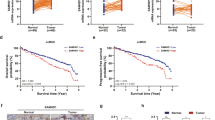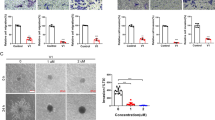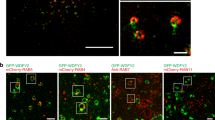Abstract
Vacuole membrane protein 1 (Vmp1) is described as a cancer-relevant cell cycle modulator, but the function of this protein and its mode of action in tumor progression are still unknown. In this study, we show that the VMP1 mRNA level is significantly reduced in kidney cancer metastases as compared to primary tumors. Further, VMP1 expression is also decreased in the invasive breast cancer cell lines HCC1954 and MDA-MB-231 as compared to the non-invasive cell lines MCF-12A, T-47D and MCF-7. We show for the first time that Vmp1 is a plasma membrane protein and an essential component of initial cell–cell contacts and tight junction formation. It interacts with the tight junction protein Zonula Occludens-1 and colocalizes in spots between neighboring HEK293 cells. Downregulation of VMP1 by RNAi results in loss of cell adherence, and increases the invasion capacity of the non-invasive kidney cancer cell line Caki-2. In conclusion, our findings establish Vmp1 to be a novel cell–cell adhesion protein and that its expression level determines the invasion and metastatic potential of cancer cells.
This is a preview of subscription content, access via your institution
Access options
Subscribe to this journal
Receive 50 print issues and online access
$259.00 per year
only $5.18 per issue
Buy this article
- Purchase on Springer Link
- Instant access to full article PDF
Prices may be subject to local taxes which are calculated during checkout




Similar content being viewed by others
Accession codes
References
Ando-Akatsuka Y, Yonemura S, Itoh M, Furuse M, Tsukita S . (1999). Differential behavior of E-cadherin and occludin in their colocalization with ZO-1 during the establishment of epithelial cell polarity. J Cell Physiol 179: 115–125.
Arlt D, Huber W, Liebel U, Schmidt C, Majety M, Sauermann M et al. (2005). Functional profiling: from microarrays via cell-based assays to novel tumor relevant modulators of the cell cycle. Cancer Res 65: 7733–7742.
Benoliel AM, Pirro N, Marin V, Consentino B, Pierres A, Vitte J et al. (2003). Correlation between invasiveness of colorectal tumor cells and adhesive potential under flow. Anticancer Res 23: 4891–4896.
Boer JM, Huber WK, Sültmann H, Wilmer F, von Heydebreck A, Haas S et al. (2001). Identification and classification of differentially expressed genes in renal cell carcinoma by expression profiling on a global human 31 500-element cDNA array. Genome Res 11: 1861–1870.
Chen X, Cheung ST, So S, Fan ST, Barry C, Higgins J et al. (2002). Gene expression patterns in human liver cancers. Mol Biol Cell 13: 1929–1939.
Dusetti NJ, Jiang Y, Vaccaro MI, Tomasini R, Azizi Samir A, Calvo EL et al. (2002). Cloning and expression of the rat vacuole membrane protein 1 (VMP1), a new gene activated in pancreas with acute pancreatitis, which promotes vacuole formation. Biochem Biophys Res Commun 290: 641–649.
Higgins JP, Shinghal R, Gill H, Reese JH, Terris M, Cohen RJ et al. (2003). Gene expression patterns in renal cell carcinoma assessed by complementary DNA microarray. Am J Pathol 162: 925–932.
Hirokawa T, Boon-Chieng S, Mitaku S . (1998). SOSUI: classification and secondary structure prediction system for membrane proteins. Bioinformatics 14: 378–379.
Martin TA, Jiang WG . (2001). Tight junctions and their role in cancer metastasis. Histol Histopathol 16: 1183–1195.
Mehrle A, Rosenfelder H, Schupp I, del Val C, Arlt D, Hahne F et al. (2006). The LIFEdb database in 2006. Nucleic Acids Res 34: D415–D418.
Sahin O, Lobke C, Korf U, Appelhans H, Sültmann H, Poustka A et al. (2007). Combinatorial RNAi for quantitative protein network analysis. Proc Natl Acad Sci USA 104: 6579–6584.
Sauermann M, Hahne F, Schmidt C, Majety M, Rosenfelder H, Bechtel S et al. (2007). High-throughput flow cytometry-based assay to identify apoptosis-inducing proteins. J Biomol Screen 12: 510–520.
Starkuviene V, Liebel U, Simpson JC, Erfle H, Poustka A, Wiemann S et al. (2004). High-content screening microscopy identifies novel proteins with a putative role in secretory membrane traffic. Genome Res 14: 1948–1956.
Sültmann H, von Heydebreck A, Huber W, Kuner R, Buness A, Vogt M et al. (2005). Gene expression in kidney cancer is associated with cytogenetic abnormalities, metastasis formation, and patient survival. Clin Cancer Res 11: 646–655.
Vleminckx K, Vakaet Jr L, Mareel M, Fiers W, van Roy F . (1991). Genetic manipulation of E-cadherin expression by epithelial tumor cells reveals an invasion suppressor role. Cell 66: 107–119.
Wiemann S, Weil B, Wellenreuther R, Gassenhuber J, Glassl S, Ansorge W et al. (2001). Toward a catalog of human genes and proteins: sequencing and analysis of 500 novel complete protein coding human cDNAs. Genome Res 11: 422–435.
Acknowledgements
We thank Ute Ernst, Christina Bootz, Sara Burmester, Heike Wilhelm, Esther Backes, Nina Claudino, Stefanie Krauth and Jens Mattern for excellent technical assistance, and Markus Ruschhaupt, Holger Fröhlich and Olga Freidekind for help in TaqMan data analysis. Further we thank Alberto Calabro for providing us with mRNAs. This work was supported by the Grants 01GR0420 (AP and SW) and 01GR0418/9 (AP and HS) of the National Genome Research Network, funded by the Federal Ministry for Education and Research (Bundesministerium für Bildung und Forschung, BMBF) and by the Austrian Genome Program GEN-AU.
Author information
Authors and Affiliations
Corresponding authors
Additional information
Supplementary Information accompanies the paper on the Oncogene website (http://www.nature.com/onc).
Rights and permissions
About this article
Cite this article
Sauermann, M., Sahin, Ö., Sültmann, H. et al. Reduced expression of vacuole membrane protein 1 affects the invasion capacity of tumor cells. Oncogene 27, 1320–1326 (2008). https://doi.org/10.1038/sj.onc.1210743
Received:
Revised:
Accepted:
Published:
Issue Date:
DOI: https://doi.org/10.1038/sj.onc.1210743
Keywords
This article is cited by
-
High-throughput functional screen identifies YWHAZ as a key regulator of pancreatic cancer metastasis
Cell Death & Disease (2023)
-
An autoregulatory feedback loop of miR-21/VMP1 is responsible for the abnormal expression of miR-21 in colorectal cancer cells
Cell Death & Disease (2020)
-
TMEM49-related apoptosis and metastasis in ovarian cancer and regulated cell death
Molecular and Cellular Biochemistry (2016)
-
VMP1-deficient Chlamydomonas exhibits severely aberrant cell morphology and disrupted cytokinesis
BMC Plant Biology (2014)
-
MicroRNAs as Biomarkers for Ischemic Heart Disease
Journal of Cardiovascular Translational Research (2013)



